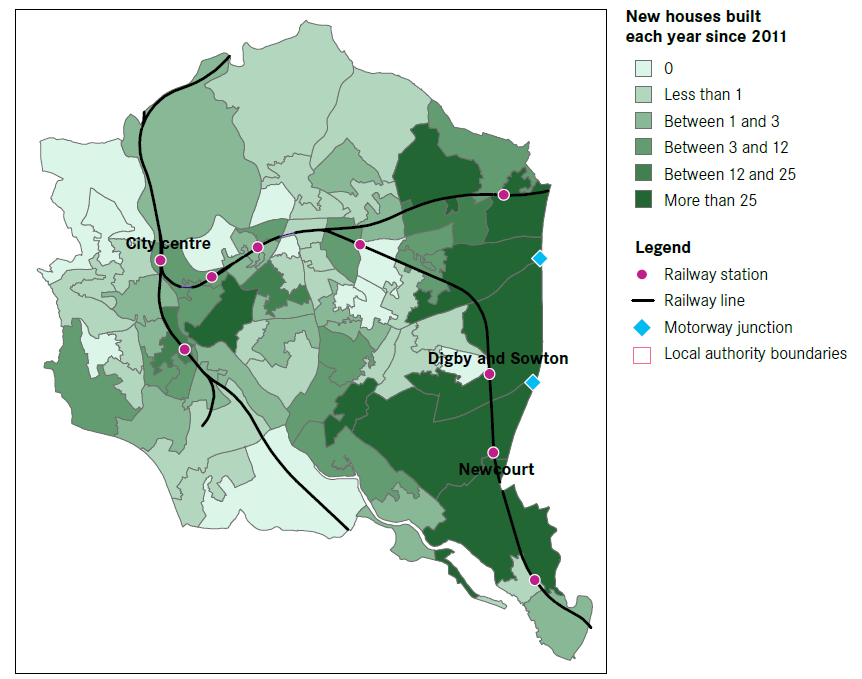There are three things which are connected yet almost unique about the British economy. It has exceptionally stark geographic inequality; it has an extremely sharp housing crisis in its most expensive cities; and it has an unusually dysfunctional planning system.
Addressing those regional divides and the housing shortage requires replacing our discretionary planning system with a new flexible zoning system. The new reforms underway are one approach, but there are other examples from abroad which would also be major improvements over what we have now. But there must be fundamental change in how the planning system works if we want fundamental changes in inequality and housing outcomes.
Our discretionary planning system rations new homes
The current planning system is highly discretionary. This means that the planning system is empowered with a great deal of discretion to decide whether a development should take place on a specific site or not. In effect, new homes are rationed by the planning system, case-by-case.
Although there is often a local plan which “leads” development, this is not always true – York has not agreed one since the 1950s. Even when there is a local plan, the real power as to whether new homes can be built or not is in the case-by-case decisions by planners and planning committees. Applying for planning permission to build private homes, affordable homes, or social housing is never certain. One in ten planning applications fail, despite the fact that developers are presenting proposals they believe will succeed.
The discretionary planning system makes inequality worse
This discretionary planning system creates poor outcomes which have previously been set out in Red Brick, and which underpinned Centre for Cities’ contributions to the Labour Planning Commission. It forces new development into the sites with the lowest political costs rather than the sites most suitable for new homes. This is why half of all suburban neighbourhoods build less than one house a year and a fifth build zero, even though these neighbourhoods already have the infrastructure to absorb some population growth over a long timeframe.
The discretionary element also makes inequality worse, as it decouples the local supply of new homes from local demand. Some of the most expensive and prosperous cities in the country, such as Bournemouth and Oxford, build far less housing than cities with weaker economies such as Wakefield and Telford. These local housing shortages mean that the average house in Oxford costs 17 times the average income, and 6 times average incomes in Wakefield.
This mismatch between supply and demand creates terrible housing crises in the cities with the most successful labour markets and fuels inequality. In expensive cities, it widens divides between renters and homeowners. As housing costs for renters in Bristol increase, so does the wealth of their homeowning neighbours as house prices rise.
But it also creates divides across the country. As we do not build enough homes in cities like Brighton to stabilise prices, average housing equity per house in Brighton rose by £89,000 from 2013-2018. But an identical twin of such a homeowner in Sunderland would only have gained £3,000, as local land values have not risen due to the struggling local economy. This is the opposite of levelling up – the planning system redistributes wealth from the poor to the rich.
The discretionary design of the planning system creates a permanent shortage of homes
For reform to solve these problems, we need to understand why the planning system systemically creates them. The explanation lies in the discretionary, case-by-case decision making of the current planning system. Few places abroad have such a system where this feature is so important. Ireland and San Francisco are two locations which do, and accordingly have dire housing shortages.
In fact, England’s discretionary planning system can be understood most clearly by comparing it to the planning systems of the former Eastern Bloc. In these planned economies, production was also rationed by the discretionary and uncertain granting of permits by planners, but for things such as mayonnaise or cars rather than new homes. Many of the behaviours which are sometimes described in England as unique to housing popped up across sectors in these Soviet-style economies – shortages, equivalents to land-banking, absorption rates, endless negotiations between planners and firms, poor quality new products, inequality in access to supply and speculation, among others.
These are more than just parallels. Both the former Eastern Bloc and the UK housing market are “shortage economies”. Their permanent state of undersupply is maintained by how the discretionary design of their planning institutions rations production, and is the defining characteristic of their systems. A few policy tweaks here or there or a little bit more funding won’t solve this core problem.
Instead England’s planning system needs fundamental reform which learns from other planning systems abroad that result in better housing outcomes, and for the discretionary element in our system to be minimised or removed.
England’s new zoning system is a move in the right direction
Moving away from a discretionary system implies a new flexible zoning system, where provided a proposal agrees with the local plan and building regulations so that the new structures are safe, it legally must be granted permission. This is a common form of planning around the world.
The new zoning reforms introduced earlier this month – establishing growth, renewal, and protected zones in England – are a big step in this direction. Within growth zones, there is no discretionary element, as the principle of development is already accepted by the zoning. Developments which comply with a design code and legally must be granted planning permission, after planning has resolved technical elements such as road layouts. This certainty will, within growth zones, end the unpredictable rationing of new homes that the current planning system creates, and by extension, address the housing shortage.
We can argue about the details, but we need a new zoning system to end the housing crisis
There are political choices to be made as to the inner workings of such a new zoning system, and Centre for Cities has previously set out how these could work. Japan is the clearest example of such an alternative framework abroad, where there are twelve different zones which shape the density and use of land while still providing much more flexibility than our current system.
As a result, Japan has much more affordable housing than England, as it builds 900,000 homes a year while England struggles to build 240,000. An English flexible zoning system could achieve this too. We could also make the political choice to provide far more social housing than Japan, or have a greater focus on energy efficiency and climate change, or public realm and design, and the Labour Planning Commission set out some of these areas as priorities.
But while the details of such a new flexible zoning system are contestable, the principle that we need one to solve the housing crisis is not. The discretionary granting of planning permissions is the single biggest systemic problem with our framework. If we want to improve the conditions and affordability of homes across England, we need to do things differently. We need to replace our planning system with a new flexible zoning system.




